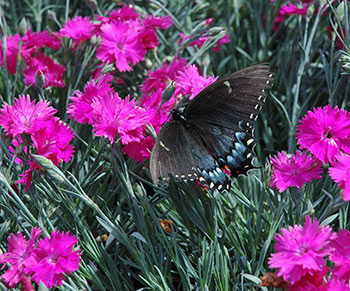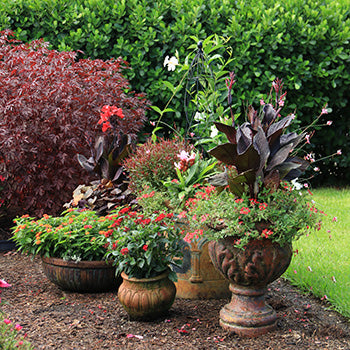By Justin Hancock

Want to make a butterfly garden? Good news: It’s easy! You don’t need a ton of space -- just a few of the right plants, a sunny spot, and a little patience.
Start by carving out the corner of your yard where you want to start your butterfly garden. If you have grass growing there, remove the grass and work the ground so you have soft, loose soil to plant in. If the soil is challenging -- with excessive sand or clay, for example, add a liberal amount of compost to help give your plants a jump start. How much compost should you add? As much as you have: There’s no such thing as too much compost.
It’s helpful to site your butterfly garden near shrubs or small trees where butterflies can hide from predators and find shelter from harsh weather. While being located near a source of shelter is helpful, butterflies love the sun so be sure you’re planting in a sunny spot.
Nectar Plants for a Butterfly Garden
There are two types of plants you need to have for your butterfly garden. The obvious ones are nectar plants, which feed adult butterflies. Some top nectar plants include:
- Aster
- Blanketflower (Gaillardia)
- Butterfly bush (Buddleia)
- Coneflower (Echinacea)
- Cosmos
- Firebush (Hamelia)
- Heliotrope (Heliotropium)
- Lantana
- Pentas
- Salvia
- Verbena
- Yarrow (Achillea)
- Zinnia
Host Plants for a Butterfly Garden
The other category of plant you’ll need for a butterfly garden is host plants. While adult butterflies visit nectar plants for sustenance, they’re even more strongly attracted to host plants, on which they lay eggs. The eggs hatch into caterpillars, which hungrily eat the host plants. Don’t expect your host plants to look perfect -- the point of planting them is that they’ll have caterpillars chewing them up. If keeping your plants looking clean and fresh is important to you, try hiding your host plants behind your nectar plants where you’re less likely to notice the damage from the caterpillars feeding.
Most butterflies have specific host plants, so if you want to attract specific butterflies, it’s helpful to do a little research. Here are some common host plants and the butterflies they attract:
- Baptisia attracts Sulphur and Frosted Elfin butterflies
- Dill (Antheum) attracts Swallowtail butterflies
- Hops (Humulus) attracts Mourning Cloak butterflies
- Marigold (Tagetes) attracts Sulphur butterflies
- Milkweed (Asclepias) attracts Monarch butterflies
- Orange (Citrus) attracts Skipper butterflies
- Parsley (Petroselinum) attracts Swallowtail butterflies
- Passionflower (Passiflora) attracts Zebra Longwing, Julia, and Gulf Fritillary butterflies
- Sunflower (Helianthus) attracts Checkerspot butterflies
- Texas sage (Leucophyllum) attracts Checkerspot butterflies
- Tomatoes (Lycopersicon) attracts Hummingbird moths
- Yarrow (Achillea) attracts Painted Lady butterflies
Other Butterfly Garden Considerations
After you plant your butterfly garden, spread several inches of mulch over the soil to help suppress the growth of weeds and keep the soil moist longer during times of drought. In a butterfly garden, you may not need to worry as much about weeds as some weed species are good butterfly attractors, as well.
Providing a water source can also be helpful. Some gardeners fill a dish with sand and water and leave that in the garden; the sand gives the butterflies a place to land, but they’re still able to drink water in between the sand granules. devices or soaker hoses also work.
Once you have a butterfly garden, suppress the use of pesticides -- especially insecticides -- in your yard so you don’t harm butterflies or caterpillars.
Butterfly Gardening Questions?
We love to talk to other gardeners. Email us your questions and we'll have one of our experts get back to you!

















